Every day, workers at grocery stores and convenience stores in Montana carry out a sad ritual. They come in, check the “sell-by” dates on their milk and throw out any milk that’s past the date.

Montana throws more milk down the drain than other states because the sell-by date on the milk is required by state law to be just 12 days after pasteurization (the industry standard is 21 days). After these 12 days, Montana law requires that the milk be thrown away. It can’t be sold or donated. Thousands of gallons of milk are thrown away each week that many believe is perfectly fine to drink.
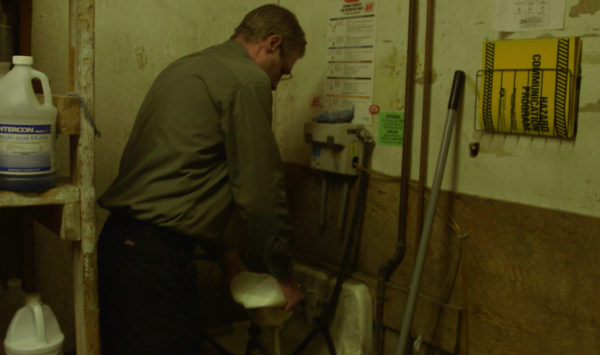
In theory, Montana’s strict date label law is about food safety and protecting the consumer. But it hasn’t been updated since the 80s, and some believe it’s more about protecting the interests of the dairy industry.
Date labels, of course, aren’t just on milk, they’re on a lot of products. Forty-one states require a date label on at least some food product but there are huge inconsistencies, not just in the wording, but in the meaning of these labels. Some states require them only on dairy, some on shellfish, some on any perishable foods.
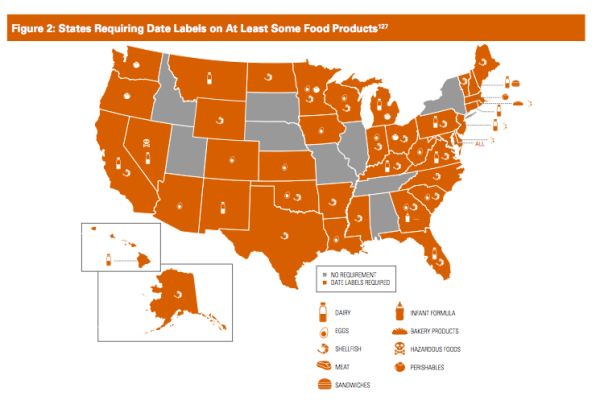
It’s become complicated to decipher these dates or to know how to act on them, for large retailers and individual consumers alike. And despite what many people assume, they are not about food safety and were actually never meant to be.
It all began in the 1970s. Americans had moved further away from their food sources and were eating more packaged foods and getting more of their food in supermarkets. Consumers wanted a way to measure how fresh their food was. At the time, most manufacturers already put encrypted dates on their products to help retailers rotate stock and consumers craved access to this information.
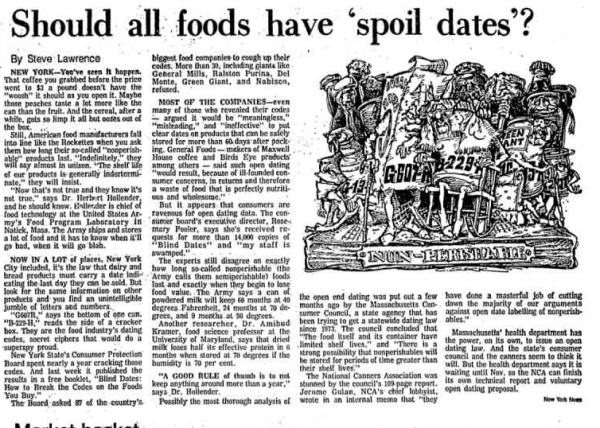
In 1977, the New York State Consumer Protection Board published a booklet called Blind Dates: How to Break the Codes on the Foods You Buy. The booklet told consumers how to decipher the encrypted date codes on their favorite products. The board distributed more than 10,000 copies and posted the booklet in supermarkets.
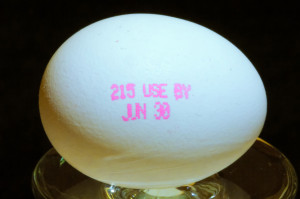
Eventually, consumers started to demand that these dates be put clearly on packaging, and retailers and grocery stores responded. A few states began to regulate these date labels, but there was no federal-level regulation, even though there were a number of attempts. Still, consumers wanted freshness dates, so all kinds of different ones popped up (“use-by”, “sell-by”, “best-by”, “best if used by,” “expires on”). Some dates were stamped right on the product, some printed on the label. There was no consistency in how this information was displayed or the language that was used.
Some companies even tried to use “freshness dating” to sell their products, like in this Pepsi commercial:
Some date labels were meant for consumers, while others were just meant for retailers. And as is still true now, There were no clear definitions for any of the phrases and no consistency even within the same brand or product. Dates could differ from state-to-state, manufacturer-to-manufacturer, or store-to-store.
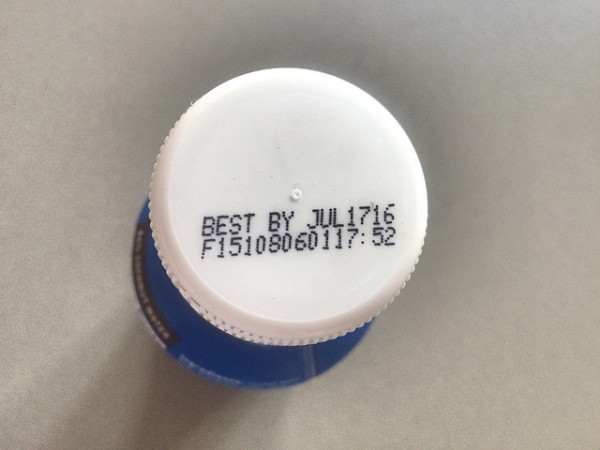
Over the years we’ve lost track of what these labels meant in the first place. We’ve come to associate the dates with safety, when in fact, they’ve always been about freshness. As much as we might want them to, the dates on our food are not going to tell us if we’ll get salmonella or e-coli.
Most date labels are arrived at by conducting taste tests. Does a product still taste good on day 4? Day 5?
And yet today, according to a report that Emily Broad-Leib co-authored, a majority of consumers believe that eating food past it’s sell-by or use-by date is a risk to their health. And as many as 90% of Americans throw out food based on date labels at least occasionally.
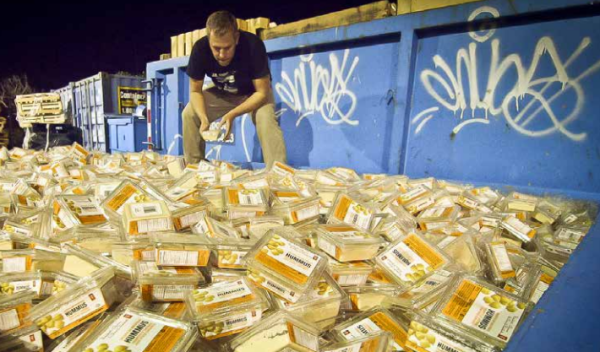
The average American wastes somewhere between 20-25% of the food they acquire. The EPA and USDA recently announced a goal to cut food waste in the U.S. in half by 2030, and having a better date labeling system is one way to get there.



Comments (11)
Share
Does anyone know when we will receive the 99% Coin?
I love this particular podcast. I’m almost always mindful of the amount of food/water I take and make sure I eat as appropriate and help my friends and family come to understand this, too.
Great episode. Reminds me of Jerry Seinfeld’s thoughts on milk. https://www.youtube.com/watch?v=Es1npWZ7zxY
Hi,
What’s the name of the food podcast you mentioned at the end? I didn’t get the name.
Thanks!
Gastropod, https://gastropod.com/category/podcasts/
You haven’t got standardised use by labelling?? Hahahahahahahaha. http://www.foodauthority.nsw.gov.au/fp/understanding-labels/best-before-and-used-by-dates
Several years ago I volunteered at our county food bank. We were instructed to throw out every container of food where the expiration date was not legible. At the end of the day, we filled an entire trash vat! Can you imagine how many people would not have gone hungry that day? When I do my weekly food shopping, it is frustrating to find what is freshest, and how to interpret the labeling to make sure I dont purchase something out of date. But, what is out of date? You cant tell because very few items actually say “expire by …..”. Not only this, but trying to find a date at all is time consuming because each manufacturer of every product stamps the dates on different parts of the container. I personally would appreciate a LEGIBLE
EXPIRATION date on every container. Let me be the one who determines the date your product is best used by!
I am the one in the family who can tell when milk goes bad. Ever since I was a kid, I have always smelled the milk before I poured it to make sure it had not spoiled. That is the truest test. I find that skim milk seems to last the longest without going bad. And I have had yogurt that has passed it’s best by date by a couple weeks (since it’s sealed and pasteurized). The only food I’ve ever gotten sick on is chicken. Several times. Usually at someone’s BBQ. So now, I do not eat Chicken at cookouts.
The being said, in Montana(?) could stores not mark down the milk on the last day? Perhaps, have a sign “Milk with todays’ date is half-price”. That would keep the store from having to throw it out. And many people would appreciate getting a deal on milk, and the store would not have to take a total loss. Or else donate it that day to a food bank. Maybe it’s ‘cheaper’ for the store to dump it rather than sell it for a lower price? But it’s a shame to see it go to waste.
I think the wording change from EXPIRATION to BEST BY is a good one, since people think that, magically, once that EXPIRATION day has hit, the food is spoiled and they have to throw it out. By saying BEST BY, the consumer will know that it still may be OK, but not quite as fresh, and not waste it.
Organic milk last the longest without going bad as it uses a different pasteurization process (ultra-pasteurization). One of the few organic products I actually buy.
NPR has a really great episode about the same topic:
http://www.npr.org/sections/thesalt/2012/12/26/167819082/dont-fear-that-expired-food
One of the highlights is the discussion about Vinegar. Manufacturers recently changed the “expiration date” of vinegar from 7 years to 1 year. But what does vinegar turn into when it expires? Vinegar.
These codes are meant for the vendors to know when to pull product. I was bread and coffee salesman/merchant. Trust me all the so called stale bread and out of code coffe I pulled tasted great long paste the date on the product. Milk bought on the day of the pull date code once opened will still be good 5 days later. People need to use common sense which is on shirt supply, but come on. Unless your bread is hard or moldy it’s good bread